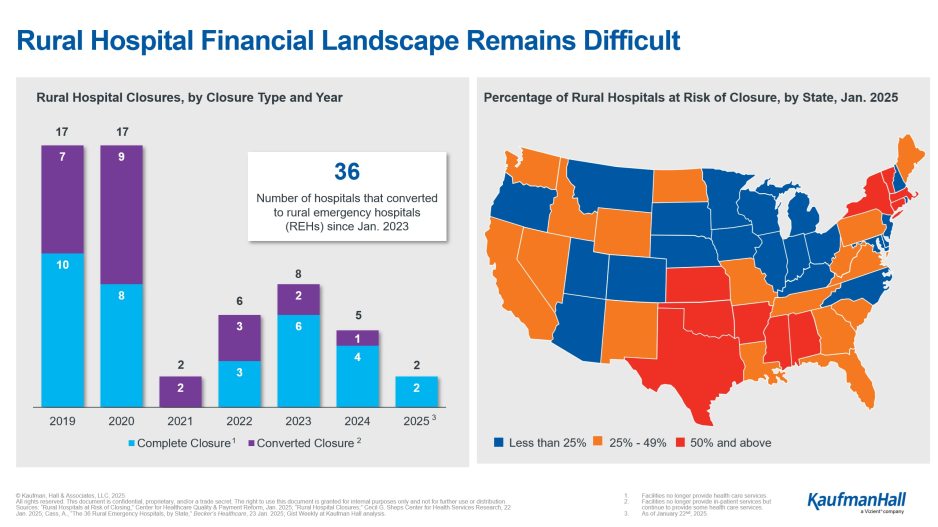Happy Lincoln’s Birthday

Our greatest President
From Washington, DC
Capitol Hill News
- The American Hospital Association (AHA) News tells us,
- House Republicans Jan. 12 released a budget resolution for fiscal year 2025 focusing on the Trump administration’s agenda on border security, defense, energy and taxes. The budget resolution, which acts as an outline for the reconciliation process, calls for increasing the debt ceiling by $4 trillion and allows for $4.5 trillion in spending for tax cuts. It also would allocate $200 billion for border and defense spending. The resolution instructs seven committees to come up with no less than $1.502 trillion in mandatory cuts over ten years.
- Notably, for health care, the bill instructs the House Energy and Commerce Committee to cut mandatory spending by no less than $880 billion. The committee has primary jurisdiction over a number of health care programs, including Medicaid, and some proposals have been circulating that would enact significant cuts to Medicaid. The House is expected to mark up its budget resolution tomorrow.
- Politico adds,
- “Senate Republicans easily pushed their budget resolution out of committee on Wednesday — the first step toward being able to enact President Donald Trump’s massive domestic policy agenda.
- “The Senate Budget Committee voted 11-10, along party lines, to approve the fiscal framework meant to tee up a package of energy, border security and defense policy through the partisan budget reconciliation process. Across the Capitol, House GOP leaders struggled at the same time to rally their own around a far more expansive plan that would pave the way for legislation that would bundle those same policies alongside trillions of dollars in tax cuts.”
- The Senate Invoked, 53-47: Motion to invoke cloture on Executive Calendar #17 Robert F. Kennedy, Jr. to be Secretary of HHS. The Senate is expected to confirm Mr. Kennedy’s nomination as HHS Secretary Thursday morning.
- Senators Chuck Grassley (R IA) and Maria Cantwell (D WA) have re-introduced the PBM reform bills that nearly passed Congress last December.
- Prescription Pricing for the People Act:
- Pharmacy Benefit Manager (PBM) Transparency Act:
- Fierce Healthcare lays out the “top policy issues for hospitals, payers, docs and tech” on Capitol Hill this year.
White House news
- Here is a link to the President’s February 11 executive order captioned “IMPLEMENTING THE PRESIDENT’S “DEPARTMENT OF GOVERNMENT EFFICIENCY” WORKFORCE OPTIMIZATION INITIATIVE,” which was mentioned in Tuesday’s report.
- The American Society of Pension Professionals and Actuaries lets us know,
- “Daniel Aronowitz has been officially nominated by the White House to become next Assistant Secretary of Labor for the Employee Benefits Security Administration (EBSA). He is the President of Euclid Fiduciary (now Encore Fiduciary), a fiduciary liability insurance underwriting company for employee benefit plans.
- “His experience in the professional liability industry includes expertise as a coverage lawyer and underwriter.”
- The AHA News informs us, “Tom Engels is the new administrator for the Health Resources and Services Administration, according to its website. Engels previously held the same position in the first Trump administration from 2019 to 2021.”
- Federal News Network updates us on federal agency efforts to bring their workforces back to office.
Judicial front
- Federal News Network reports,
- “The Trump administration is free to continue implementing its controversial deferred resignation program after a federal court in Massachusetts dissolved a restraining order that had delayed the program’s deadline by several days.
- “In a written opinion Wednesday afternoon, Judge George O’Toole said he had determined that the three federal unions that had challenged the program lacked the standing they’d need in order to meet the legal standard for a temporary restraining order.” * * *
- “Wednesday’s ruling does not completely end the legal challenge — it only affects the unions’ requests for a temporary pause in the deferred resignation program while their claims work their way through the litigation process. However, in denying a temporary restraining order and preliminary injunction, O’Toole said he had determined the unions were unlikely to succeed on the merits of their case.
- “OPM is pleased the court has rejected a desperate effort to strike down the deferred resignation program. As of 7 p.m. tonight, the program is now closed,” said McLaurine Pinover, a spokeswoman for the office. “There is no longer any doubt: the deferred resignation program was both legal and a valuable option for federal employees. This program was carefully designed, thoroughly vetted, and provides generous benefits so federal workers can plan for their futures.”
- In fact, the Fork in the Road program closed at 7:20 pm ET Wednesday night per its website.
FDA News
- Fierce Pharma notes,
- “More than 13 years after its initial FDA approval, Pfizer’s blood cancer drug Adcetris has nabbed another regulatory green light to treat large B-cell lymphoma (LBCL).
- “The CD30-directed antibody-drug conjugate has been approved in combination with lenalidomide and rituximab for certain LBCL patients, the FDA said Wednesday. Eligible patients must have tried at least two prior lines of systemic therapy and be ineligible for an autologous hematopoietic stem cell transplant or a CAR-T therapy.
- “Adcetris won the approval after showing it helped patients with heavily pretreated LBCL live longer in a phase 3 trial.”
From the public health and medical research front,
- CBS News reports,
- “For the first time since the beginning of the pandemic, more people in the U.S. died of influenza than from COVID-19 in the week ending on Jan. 25, according to weekly figures published by the Centers for Disease Control and Prevention.
- “For the week ending on Jan. 25, nearly 1.7% of all deaths nationwide were attributed to the flu, compared to roughly 1.5% being the result of COVID-19, according to CDC data. Rates of influenza hospitalizations are more than three times higher than COVID-19 hospitalizations amid this season’s record wave of flu infections.”
- and
- “The U.S. confirmed at least a dozen deaths from whooping cough last year, according to preliminary figures released this week by the Centers for Disease Control and Prevention. That marks the most fatalities from the bacterial infection since a 2017 surge of the illness, which is also known as pertussis.
- “Over the last month, pertussis infections have been rising again. While cases reported to the CDC by health departments dipped over the winter holidays, weekly infections have accelerated for a month straight since then.”
- The New York Times adds,
- “A worsening measles outbreak has taken root in Texas, sickening two dozen and hospitalizing nine on the western edge of the state, where childhood vaccination rates have dwindled in recent years.
- “As of Tuesday, 22 children and two adults had been infected, all of whom were unvaccinated, local health officials said. * * *
- “The Texas outbreak has so far been limited to residents of Gaines County, which borders New Mexico and has roughly 20,000 residents. Last year 82 percent of kindergarten students received the measles, mumps and rubella vaccine, according to state data. That figure is roughly 10 percentage points lower than the average vaccination rate in Texas public schools and far below the federal target of 95 percent for measles vaccination.”
- Nature points out that “Dozens of new obesity drugs are coming; these are the ones to watch. Next-generation obesity drugs will work differently from Ozempic and Wegovy — aiming to deliver greater weight loss with fewer side effects.”
- BioPharma Dive, on the other hand, lets us know “A small semaglutide trial suggests the medicine’s suppression of appetite may extend to alcohol, but larger trials are needed to establish a conclusive benefit.”
- Per Fierce Healthcare,
- “More than five years ago, Apple launched three medical studies to test how well its Apple Watch can track a person’s mobility and cardiovascular health, changes in hearing and women’s health and fertility.
- “The tech company is now broadening its health research ambitions to use its devices, including iPhones, Apple Watch and AirPods along with third-party devices, for a longitudinal, virtual study to monitor changes in participants’ health, spanning a wide range of health and disease areas.
- “Apple wants to tap into the devices and apps that individuals use every day to evaluate the connections between physical and mental health as well as social determinants, such as whether someone lives alone or with family, and how all these aspects of health factor into a person’s overall well-being.”
From the U.S. healthcare business front,
- Healthcare Dive reports
- “CVS Health’s profits were nearly cut in half last year as the healthcare giant wrestled with elevated medical costs in its Aetna insurance business.
- “The company reported net income of $4.6 billion in 2024, compared with $8.4 billion in the prior year, according to earnings results released Wednesday.
- “But CVS showed signs of financial improvement in the fourth quarter, beating Wall Street expectations on earnings and revenue.”
- Bloomberg explains,
- “In the insurance unit, CVS spent 94.8% of premium revenue on medical care in the quarter, less than analysts expected. Investors prefer a lower number. However, CVS said in a separate filing that high use of medical services will continue to pressure the business.
- “The company pointed in particular to high costs in its business that manages care for patients on Medicaid, the US health program for the poor. States have been cutting Medicaid rolls since the pandemic, often culling healthier patients in the program while sicker patients remain.”
- Fierce Healthcare adds,
- “CVS Health CEO David Joyner went on the defense of the pharmacy benefit management industry on the company’s Q4 earnings call Wednesday morning.” * * *
- “One of the most powerful forces helping to offset rising healthcare costs is PBMs like Caremark,” Joyner said. “These entities remain the only part of the drug supply chain and entirely focused on lowering costs, but have erroneously been subject to deceptive rhetoric and misinformation.”
- “Joyner noted that branded pharmaceutical manufacturers “added $21 billion of annual gross drug spend through their price actions” in January. Drugs where PBMs lack tools to negotiate prices have seen prices rise more than twice as fast as other products, he said.
- “In addition, Joyner said that “multiple well-known economists” have projected that PBMs create $100 billion in net value each year for the healthcare system.”
- Per the AHA News,
- The Council for Affordable Quality Healthcare Feb. 11 released a report highlighting how the health care industry can save $20 billion by transitioning from manual to electronic workflows.
- In addition, it found that the industry could save $515 million annually on electronic prior authorizations and save providers and staff 14 minutes per transaction.
- Per Fierce Healthcare,
- “UnitedHealth Group and Amedisys outlined plans to divest a significant number of home health and hospice locations as they seek to close their $3.3 billion merger.
- “In a court filing issued late last week, UHG said it intends to pursue a divestiture plan that would sell off “at minimum” 128 combined home health and hospice facilities. The company said in the filing that once the divestitures are completed it will operate only 10% of home health services in the U.S. and 4% of hospice services.
- “UnitedHealth argued that leaves plenty of competition in this space, as it will still be up against 11,000 home health agencies and more than 5,000 hospice agencies across the U.S.
- ‘The Department of Justice sued to block the deal in mid-November, arguing that it would hamper competition across multiple home health markets.”
- Per JAMA Open,
- “Question How have the proportion and absolute number of psychiatrists providing professional services to traditional Medicare enrollees changed as the field has grown?
- “Findings In this cross-sectional study using data from 2014 to 2022, the nationwide proportion of psychiatrists billing Medicare Part B declined from 44% in 2014 to 33% in 2022. The number of psychiatrists billing Medicare Part B declined by 3772 during a time when the total number of active psychiatrists increased by 6076.
- “Meaning These findings suggest that during a time of psychiatrist workforce growth, the proportion and number of psychiatrists accepting Medicare Part B decreased, further suggesting potential decreases in access to psychiatrist-led care for older adults and individuals with disabilities.”







